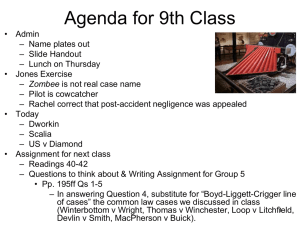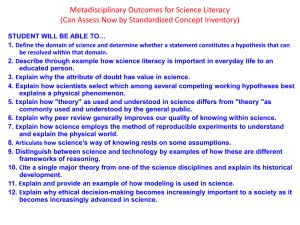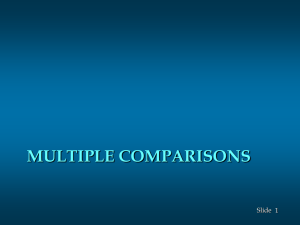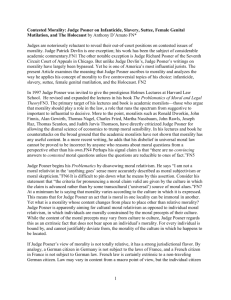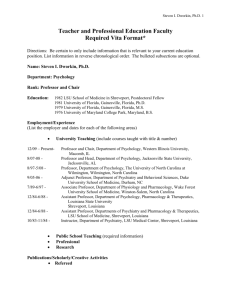Document
advertisement
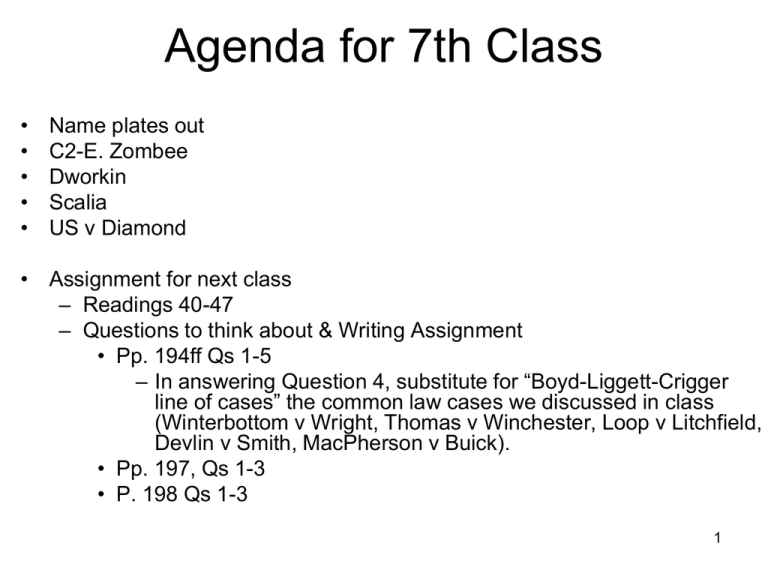
Agenda for 7th Class • • • • • Name plates out C2-E. Zombee Dworkin Scalia US v Diamond • Assignment for next class – Readings 40-47 – Questions to think about & Writing Assignment • Pp. 194ff Qs 1-5 – In answering Question 4, substitute for “Boyd-Liggett-Crigger line of cases” the common law cases we discussed in class (Winterbottom v Wright, Thomas v Winchester, Loop v Litchfield, Devlin v Smith, MacPherson v Buick). • Pp. 197, Qs 1-3 • P. 198 Qs 1-3 1 Study Tools • Portal: My Applications (left panel): Secure Documents – Model answers to all writing assignments • Portal: My Applications (left panel): Recorded Classes – Recordings for all classes • www.klerman.com, LL&V button – Slides for all classes – Grades for all writing assignments – TA Office hours • My Office hours – 10 minutes after each classes – Mondays 4-5 2 Jones Exercise • • • • Kansas trial court held that RR was liable for failure to help trespasser nonnegligently injured by RR Appellate court reversed, because no “duty to rescue” Questions – Should law clerk for Kansas Supreme Court advise affirmance or reversal? – Is there agreement on common law rule? If not, which should apply? – Need more facts? Authorities – Beach on Contributory Negligence. Railroad owes duty to trespasser to mitigate severity of injury. Train which occasioned harm must stop. Cites Zombee – Zombee, 29 Md. 420. RR negligent in operating too fast. Also, employees have duty to remove injured person with proper regard to safety and humanity (not dump in warehouse) – Cooley on Torts. Zombee only means that RR subject to duty of care when its employees took charge of injured person – Barrows on Negligence. Duty owed only by individuals, not public as a whole (no “duty to rescue”). Cites Kenney – Kenney, 70 Mo. 252. RR liable for damage caused by fire only if negligent in causing fire Theories of Adjudication • Formalism – Legal reasoning is primarily logical reasoning – Judges should not rely on moral or policy reasoning • Realism – Logical reasoning cannot answer many legal questions – Legal reasoning does and must incorporate moral and policy reasoning – Legal reasoning similar to legislative reasoning • Judge is “interstitial legislator” • Natural Law – Legal reasoning does and should incorporate unenacted principles – These principles are part of the legal system and distinct from policy reasoning – Different from realism, because relies on moral reasoning, whereas realism is open to many kinds of policy and pragmatic arguments 4 Dworkin I • An ideal judge (“Hercules”) should decide cases by – Identifying one or more principles which fit the precedents (and perhaps even relevant statutes) – If more than one principle fits the precedents, she should choose the “best” principle the precedents can be taken to serve – Analogy to chain novel • Judge not free to do what best, irrespective of precedents • Judge must make moral/political choices – Coherence and integrity – Necessitated by fairness– need to treat like cases alike • Sharp distinction between policy and principle – Arguments of policy justify a political decision by showing that the decision advances or protects some collective goal of the community as a whole. • E.g. argument for subsidy based on national defense – Arguments of principle justify a political decision by showing that the decision respects or secures some individual or group right. • E.g. argument for anti-discrimination statutes based on right to equal respect and concern. 5 Dworkin II • Judging is different from legislating – Because legislator need not legislate based on principle which makes sense of all prior legislation – Legislator can use policy, not principle • Contrasts – Legal Realists • Judge is “interstitial” legislator – Posner • No sharp distinction between principles and policies • Judge should decide common law cases to promote economic efficiency • Could reconcile with Dworkin – Economic efficiency is a principle which best fits with common law precedents (“positive economic theory of the law”) – Economic efficiency is the best such principle » Economic efficiency is an attractive principle for utilitarian and pragmatic reasons – Dworkin would reject reconciliation, because views efficiency and utilitarianism as plausible moral theories and thus as acceptable 6 principles Scalia • Realistic view of common law – Judges make the common law by selecting rule they think best and distinguishing troublesome precedents – Common Law mindset: “What is the most desirable resolution of this case, and how can any impediments to the achievements of that result be evaded?” • Common law is small part of federal judging – “We live in an age of legislation, and most new law is statutory law.” – To apply “Mr. Fix-it mentality of the common-law judge is a sure recipe for incompetence and usurpation.” • Inconsistent with democracy • Too much discretion to judges 7 U.S. v Diamond • 21 USC §841. mandates – a 5-year minimum sentence for selling more than 1 gram of a “mixture or substance containing a detectable amount” of LSD, – a 10-year minimum sentence for selling more than 10 grams of a “mixture or substance containing a detectable amount” of LSD • Lucy Diamond sold 1000 doses (50mg) of LSD on heavy blotter paper weighing 10.5 grams • Does the weight of the blotter paper count for the purposes of the mandatory minimum? 8 U.S. v Diamond • 1. Are the dictionary definitions of statutory words such as “mixture” and “substance,” together with any other linguistic or semantic facts relevant to the legal meaning of the §841(b)’s phrase “mixture or substance containing,” conclusive on the question of whether the weight of the LSD carrier should be included when determining whether the amount of drugs sold reaches the 1 gram threshold for a 5-year mandatory minimum sentence, and the 10 gram threshold for a 10-year mandatory minimum sentence? Explain. • 2. Suppose we give §841(b) the meaning that best advances the statute’s purpose or purposes (either actual intended purposes or purposes judicially imputed to the statute to make sense of it). Does §841(b) likely have just one purpose, or more than one purpose? What is that purpose (what are those purposes)? Is construing §841(b) in light of its purpose (or purposes) conclusive on the question of whether the weight 9of the LSD carrier should be included? Explain. U.S. v Diamond • 3. Assume that consistency in statutory interpretation is desirable. Does the consistency value argue in favor of including the weight of the carrier; excluding the weight of the carrier; or does it cut both ways? Explain. • 4. In his dissent in Marshall, Judge Posner describes two theories, positivism and natural law or legal pragmatism. He sets out what he takes to be the benefits and costs of both theories. Admitting that neither view is perfect, Posner ultimately prefers natural law or legal pragmatism and applies it to the problem of interpreting §841(b). Posner concludes that the best reading of §841(b) is one in which the “filler” counts in the sentence calculus in cocaine and heroin cases, but the “carrier” does not count in LSD cases. • 4.1. What does Posner mean by positivism? Do you agree with Posner that within a positivist understanding of the statute, the weight of the LSD carrier must be included? • 4.2. What does Posner mean by natural law and legal pragmatism? Do you agree with Posner that within a natural law or legal pragmatist understanding of the statute, the weight of the LSD carrier should not be included? 10
